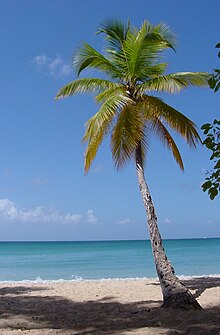| Arecaceae Temporal range: Late Cretaceous – Recent (possible Albian record)[1]
| |
|---|---|

| |
| Coconut (Cocos nucifera) in Martinique | |
| Scientific classification | |
| Kingdom: | Plantae |
| Clade: | Tracheophytes |
| Clade: | Angiosperms |
| Clade: | Monocots |
| Clade: | Commelinids |
| Order: | Arecales |
| Family: | Arecaceae Bercht. & J.Presl, nom. cons.[2] |
| Type genus | |
| Areca | |
| Subfamilies[3] | |
| Diversity | |
| Well over 2600 species in some 202 genera | |
| Synonyms | |
| |
The Arecaceae (/ærəˈkeɪsiaɪ/) is a family of perennial, flowering plants in the monocot order Arecales. Their growth form can be climbers, shrubs, tree-like and stemless plants, all commonly known as palms. Those having a tree-like form are colloquially called palm trees.[4] Currently, 181 genera with around 2,600 species are known,[5][6] most of which are restricted to tropical and subtropical climates. Most palms are distinguished by their large, compound, evergreen leaves, known as fronds, arranged at the top of an unbranched stem, except for the Hyphaene genus, who has branched palms. However, palms exhibit an enormous diversity in physical characteristics and inhabit nearly every type of habitat within their range, from rainforests to deserts.
Palms are among the best known and most extensively cultivated plant families. They have been important to humans throughout much of history, especially in regions like the Middle East and North Africa. A wide range of common products and foods are derived from palms. In contemporary times, palms are also widely used in landscaping. In many historical cultures, because of their importance as food, palms were symbols for such ideas as victory, peace, and fertility.
- ^ "Bajo Comisión - Kachaike Formation (Cretaceous to of Argentina)". PBDB.org.
- ^ Angiosperm Phylogeny Group (2009). "An update of the Angiosperm Phylogeny Group classification for the orders and families of flowering plants: APG III". Botanical Journal of the Linnean Society. 161 (2): 105–121. doi:10.1111/j.1095-8339.2009.00996.x. hdl:10654/18083.
- ^ "Arecaceae Bercht. & J. Presl, nom. cons". Germplasm Resources Information Network. United States Department of Agriculture. 2007-04-13. Archived from the original on 2009-08-11. Retrieved 2009-07-18.
- ^ The name "Palmaceae" is not accepted because the name Arecaceae (and its acceptable alternative Palmae, ICBN Art. 18.5 Archived 2006-05-24 at the Wayback Machine) are conserved over other names for the palm family.
- ^ Baker, William J.; Dransfield, John (2016). "Beyond Genera Palmarum : progress and prospects in palm systematics". Botanical Journal of the Linnean Society. 182 (2): 207–233. doi:10.1111/boj.12401.
- ^ Christenhusz, M. J. M.; Byng, J. W. (2016). "The number of known plants species in the world and its annual increase". Phytotaxa. 261 (3): 201–217. doi:10.11646/phytotaxa.261.3.1. Archived from the original on 2016-07-29.